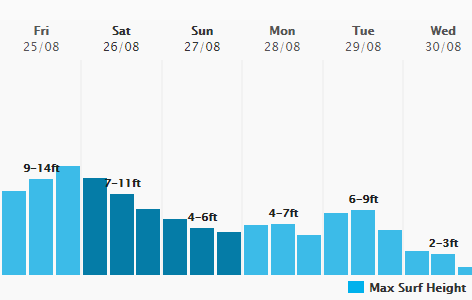Written by the TreasureGuide for the exclusive use of treasurebeachesreport.blogspot.com.
 |
| Intertwined Silver Rings Found by John C. Photo by John C. |
Thanks much for the pictures and emails John.
These are really worn very thin and show the characteristic patina and corrosion of rings that have been on the beach a good while.
If these were found on a shipwreck beach, it would seem the evidence of a shipwreck source for some of these types of rings would be building.
I've asked John and expect to hear from him soon.
I've found intertwined rings before. I think one set had one ring of gold, one of silver, and one of some other metal. I'll have to look for my records and see if I can find where they were found. I'm pretty sure it was found down south rather than on the Treasure Coast though.
If others can add to this discussion, especially if they've found similar rings, that would be helpful.
---
Harvey is now sitting off the Texas coast creating havoc. The surf, according to MagicSeaWeed will be up to possibly fourteen feet at Matagorda. I feel sorry for those people. Harvey could remain stationary as a major hurricane for a matter of days. Pray for the safety and welfare of the people.
Below is a MagicSeaWeed chart showing the predicted surf for the Matagorda area.
Hurricane Harvey almost died a couple of times before he even got started but then ended up being one of the strongest hurricanes to hit the Gulf Coast in years. It just goes to show how quickly things can change.
You probably know about the Padre Island shipwreck treasures and coins. Harvey will undoubtedly bring some of that treasure to the surface. Here is a bit of an introduction from the National Park Service.
In April 1554, three Spanish naos (a type of cargo and passenger ship similar to Columbus’s Santa Maria) went aground on Padre Island following a storm that had blown them across the Gulf of Mexico from the coast of Cuba. At the time this was the greatest disaster to ever befall the Spanish fleet in the New World. Tons of treasure bound for Spain was lost in addition to the lives of approximately three hundred passengers and crew who died from hunger, thirst, and attacks by natives as they attempted to walk back to the port of Vera Cruz.
But the story of the 1554 shipwreck does not end there nor does it end with the conclusion of the salvage operations that took place later that year. As with any important historical event, its effects resonate through the centuries and can still be felt today—if one looks for them.
First of all, the wrecks were the first documented occurrence of Europeans on the island and one of the first occurrences of Europeans in what was to become Texas. The salvage operation was the first documented instance of Europeans intentionally coming to the island and staying for an extended period.
Second, the three ships that wrecked (the Santa Maria de Yciar, the Espiritu Santo, and the San Esteban) are the oldest shipwrecks ever found in North America (excluding the Caribbean and Latin America)...
Here is the link to that web site.
https://www.nps.gov/pais/learn/historyculture/1554-1.htm
And here is link to a good article on the same subject by the Texas State Historical Association.
https://tshaonline.org/handbook/online/articles/etpfe
---
We have a good start on the blog poll about what brand metal detector you all use. It seemed like the Minelab users showed up as a block very suddenly last night. Strange!
Hoping for the safety and welfare of the people of the Texas Gulf Coast.
TreasureGuide@comcast.net
We have a good start on the blog poll about what brand metal detector you all use. It seemed like the Minelab users showed up as a block very suddenly last night. Strange!
Hoping for the safety and welfare of the people of the Texas Gulf Coast.
TreasureGuide@comcast.net
